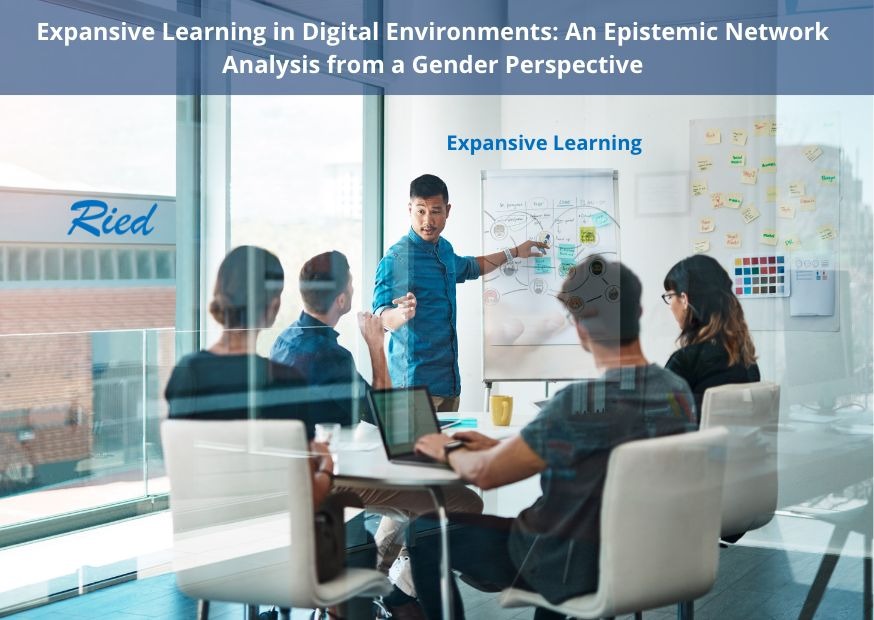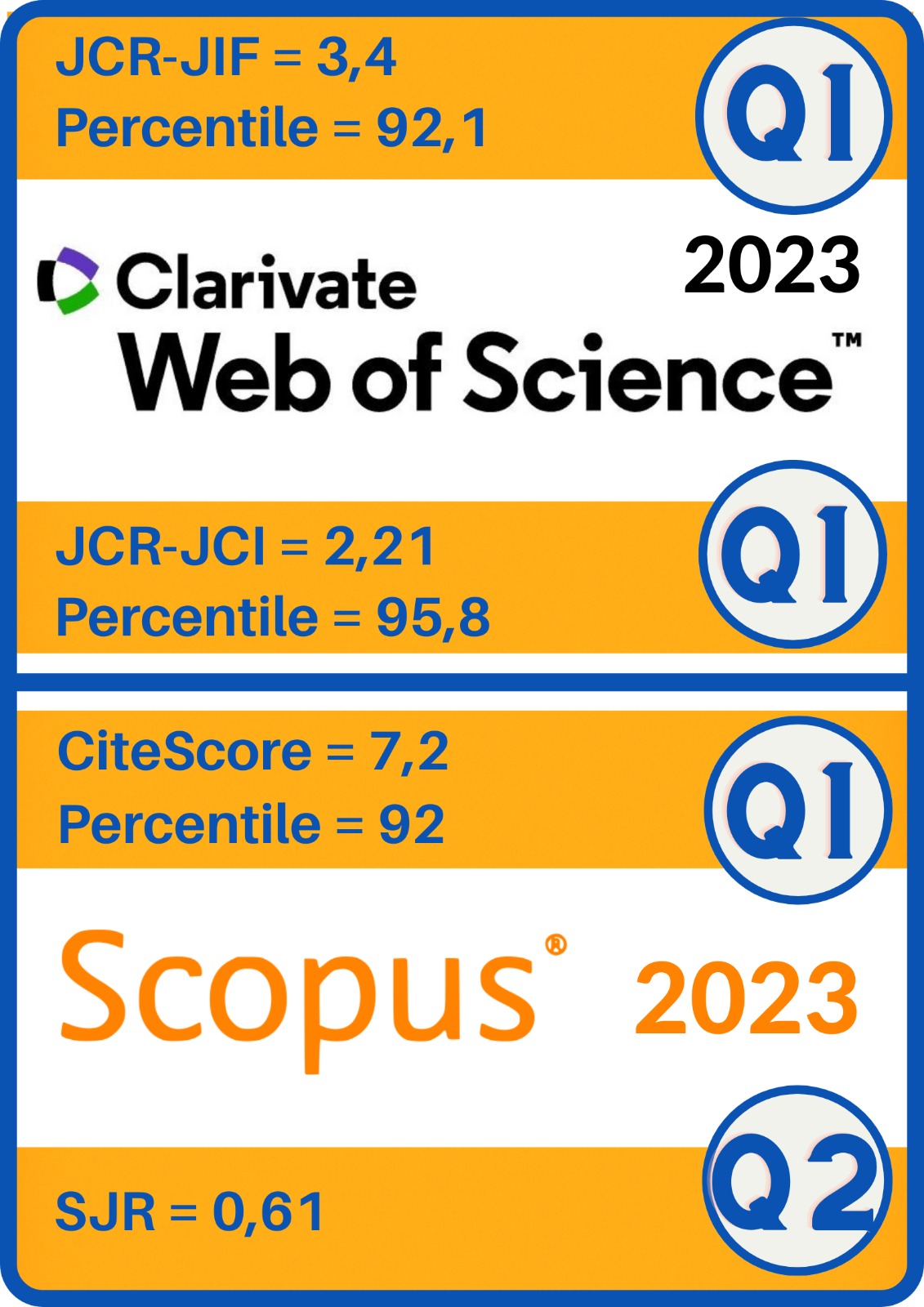Expansive Learning in Digital Environments: An Epistemic Network Analysis from a Gender Perspective
DOI:
https://doi.org/10.5944/ried.26.2.36198Keywords:
learning theory, educational technology, network analysis, distance learning university, sex differenceAbstract
Learning in digital environments faces current challenges of a different nature, including theoretical challenges. In this sense, the scientific literature on the Third Generation Activity Theory shows the need for further progress and discussion in light of digital technologies. This paper applies the Expansive Learning Theory to the evaluation of an online training intervention aimed at future distance education professionals. In order to do this, a quantitative ethnographic method is followed and 158 discursive units that occur in asynchronous forums in a digital environment are subject to study by applying an epistemic network analysis (ENA). The results show four discursive profiles with significant differences between teams: empathic-conceptual discourse, representative-conceptual discourse, critical discourse and comprehensive-conceptual discourse. Expansive learning actions associated with discursive profiles and significant differences based on gender are identified between the teams T1(mixed)-T2(women), T1(mixed)-T3(women), T2(women)-T3(women), T1(mixed)-T5(men), T2(women)-T5(men) and T3(women)-T5(men). The paper represents an original contribution to advancing knowledge for the development of expansive learning theory in education and a methodological and empirical contribution on the evidence of learning mediated by digital technologies in higher education. It contributes to future research of gender-sensitive digital learning environments.
FULL ARTICLE:
https://revistas.uned.es/index.php/ried/article/view/36198/27634
Downloads
References
Alshaboul, Y., Hamaidi, D., Arouri, Y., y Alshaboul, A. (2021). COVID-19 forced shift to distance learning: preparation and challenges. Journal of Education and e-learning Research, 8(3), 349-359. https://doi.org/10.20448/journal.509.2021.83.349.359
Arastoopour, G., Shaffer, D., Swiecki, Z., Ruis, A., y Chesler, N. (2016). Teaching and Assessing Engineering Design Thinking with Virtual Internships and Epistemic Network Analysis. International Journal of Engineering Education, 32, 1492-1501. https://www.ijee.ie/contents/c320316B.html
Creswell, J. W., y Poth, C. N. (2018). Qualitative inquiry and research design: Choosing among five approaches. Sage Publications.
Díaz, M. J., y Arroyo, M. D. (2021). Community ecology and learning by expanding. A learning community for educational transformation. Pedagogika, 142(2), 43-70. https://doi.org/10.15823/p.2020.142.3
Dong, X. X., y Wang, H. H. (2018, April). Research on the design of the expansive learning model in the environment of electronic backpacks. En 2018 International Conference on Educational Reform and Management Sciences (ERMS 2018) (pp. 1-5). Atlantis Press. https://doi.org/10.2991/erms-18.2018.1
El Refae, G. A, Kaba, A., y Elletter, S. (2021). Distance learning during the COVID-19 pandemic: satisfaction, opportunities and challenges perceived by teachers and students. Interactive Technology and Smart Education, 18(3), 298-318. https://doi.org/10.1108/ITSE-08-2020-0128
Engel, A., y Coll, C. (2022). Entornos híbridos de enseñanza y aprendizaje para promover la personalización del aprendizaje. RIED-Revista Iberoamericana de Educación a Distancia, 25(1), 225-242. https://doi.org/10.5944/ried.25.1.31489
Engeström, Y. (1987). Learning by Expanding. An Activity-Theoretical Approach to Developmental Research. Orienta Konsultit.
Engeström, Y. (2016). Studies in Expansive Learning: Learning what is not yet there. Cambridge University Press. https://doi.org/10.1017/CBO9781316225363
Engeström, Y., y Sannino, A. (2010). Studies of expansive learning: foundations, findings and future challenges. Educational Research Review, 5(1), 1-24. https://doi.org/10.1016/j.edurev.2009.12.002
Engeström, Y., y Sannino, A. (2021). From mediated actions to heterogeneous coalitions: four generations of theoretical-activity studies of work and learning. Mind, Culture, and Activity, 28(1), 4-23. https://doi.org/10.1080/10749039.2020.1806328
Engeström, Y., Nuttall, J., y Hopwood, N. (2022). Transformative agency by double stimulation: Advances in theory and methodology. Pedagogy, Culture and Society, 30(1), 1-7. https://doi.org/10.1080/14681366.2020.1805499
Guest, G., Bunce, A., y Johnson, L. (2006). How many interviews are enough?: An experiment with saturation and variability of data. Field Methods, 18(1), 59-82. https://doi.org/10.1177/1525822X05279903
Kajamaa, A., Kumpulainen, K., y Rajala, A. (2018). A digital learning environment that mediates knowledge funds and student knowledge creation. Studia pedagógica, 23(4), 49-66. https://doi.org/10.5817/SP2018-4-3
Kara, M., Erdogdu, F., Kokoç, M., y Cagiltay, K. (2019). Challenges facing adult learners in online distance education: a review of the literature. Open Praxis, 11(1), 5-22. https://doi.org/10.5944/openpraxis.11.1.929
Karanasios, S., Nardi, B., Spinuzzi, C., y Malaurent, J. (2021). Moving forward with activity theory in a digital world. Mind, Culture, and Activity, 28(3), 234-253. https://doi.org/10.1080/10749039.2021.1914662
Kaup, C., y Brooks, E. (2022). A cultural historical perspective on how double stimulation triggers expansive learning: how teachers and social educators can use double stimulation to implement computational thinking in mathematics. Designs for Learning, 14(1), 151-164. https://doi.org/10.16993/dfl.206
Ko, D., Bal, A., Bird Bear, A., Sannino, A., y Engeström, Y. (2022). Transformative agency for justice: addressing racial disparity of school discipline with the indigenous learning lab. Race Ethnicity and Education, 25(7), 997-1020. https://doi.org/10.1080/13613324.2021.1969903
Liu, S., Kang, L., Liu, Z., Zhao, L., Yang, Z., y Su, Z. (2022). Explore relationships between student network characteristics, discussion topics, and learning outcomes in a course discussion forum. Journal of Computing in Higher Education, 1-34. https://doi.org/10.1007/s12528-022-09335-0
Marková, I., Zadeh, S., y Zittoun, T. (2020). Introduction to the special issue on generalisation from dialogical single case studies. Culture & Psychology, 26(1), 3-24. https://doi.org/10.1177/1354067X19888193
Medvédev, P., y Bajtín, M. (2010). La evaluación social, su papel, el enunciado concreto y la construcción poética. Enunciación, 15(1), 168-176. https://doi.org/10.14483/22486798.3115
Molina-Toro, J. F., Rendon-Mesa, P. A., y Villa-Ochoa, J. A. (2022). Contradictions in mathematical modeling with digital technologies. Education and Information Technologies, 27(2), 1655-1673. https://doi.org/10.1007/s10639-021-10676-z
Nazari, M., Farnia, M., Ghonsooly, B., y Jafarigohar, M. (2020). Contradictions in Writing Anxiety: A Qualitative Case Study of Expansive Learning among Iranian EFL Learners. Journal of Language and Translation, 10(2), 87-103.
O’Reilly, M. y Parker, N. (2013). ‘Unsatisfactory Saturation’: a critical exploration of the notion of saturated sample sizes in qualitative research. Qualitative research, 13(2), 190-197. https://doi.org/10.1177/1468794112446106
Prokopis, D., Sannino, A., y Mykkänen, A. (2022). Towards a new Beginning: Exploring the Instructional Dynamics of Learning expansive with workers in a supported living unitby youth. Journal of Workplace Learning, 34(4), 628-642. https://doi.org/10.1108/JWL-11-2021-0157
Sannino, A. (2022). Transformative Agency as deformation: how collectives achieve change in the midst of uncertainty. Pedagogy, Culture and Society, 30(1), 9-33. https://doi.org/10.1080/14681366.2020.1805493
Sannino, A., Engeström, Y., y Lemos, M. (2016). Formative interventions for expansive learning and transformative agency. Journal of the Learning Sciences, 25(4), 599-603. https://doi.org/10.1080/10508406.2016.1204547
Shaffer, D. W. (2017). Quantitative ethnography. Cathcart Press.
Shaffer, D. W., Collier, W., y Ruis, A. R. (2016). A tutorial on epistemic network analysis: Analyzing the structure of connections in cognitive, social, and interaction data. Journal of Learning Analytics, 3(3), 9-45. https://doi.org/10.18608/jla.2016.33.3
Shtaleva, N. R., Derkho, M. A., Pribytova, O. S., y Shamina, S. V. (2021). Distant learning: challenges and risks of 2020. IOP Conference Series: Earth and Environmental Science, 699(1), 012026. https://doi.org/10.1088/1755-1315/699/1/012026
Steinley, D. (2006). K‐means clustering: A half‐ century synthesis. British Journal of Mathematical and Statistical Psychology, 59(1), 1-34. https://doi.org/10.1348/000711005X48266
Turnbull, D., Chugh, R., y Luck, J. (2021). Transition to E-Learning during the COVID-19 pandemic: How have Higher Education Institutions responded to the challenge? Education and Information Technology, 26(5), 6401-6419. https://doi.org/10.1007/s10639-021-10633-w
Virkkunen, J., y Newnham, D. (2013). The Laboratory of Change: A Tool for the Collaborative Development of Work and Education. Sense editors. https://doi.org/10.1080/1360144X.2018.1478837
Williamson, B., Eynon, R., y Potter, J. (2020). Pandemic politics, pedagogies and practices: digital technologies and distance education during the coronavirus emergency. Learning, Media and Technology, 45(2), 107-114. https://doi.org/10.1080/17439884.2020.1761641
Yamazumi, K. (2021). Activity theory and collaborative intervention in education: Expanding learning in Japanese schools and communities. Routledge. https://doi.org/10.4324/9780367823542
Zhang, S., Gao, Q., Sun, M., Cai, Z., Li, H., Tang, Y., y Liu, Q. (2022). Understanding the collaborative problem solving of teacher training students: insights from an epistemic network analysis (ENA). Computers and Education, 183, 104485. https://doi.org/10.1016/j.compedu.2022.104485

Published
How to Cite
Issue
Section
License
Copyright (c) 2023 Rocío Jiménez Cortés

This work is licensed under a Creative Commons Attribution 4.0 International License.
The articles that are published in this journal are subject to the following terms:
1. The authors grant the exploitation rights of the work accepted for publication to RIED, guarantee to the journal the right to be the first publication of research understaken and permit the journal to distribute the work published under the license indicated in point 2.
2. The articles are published in the electronic edition of the journal under a Creative Commons Attribution 4.0 International (CC BY 4.0) license. You can copy and redistribute the material in any medium or format, adapt, remix, transform, and build upon the material for any purpose, even commercially. You must give appropriate credit, provide a link to the license, and indicate if changes were made. You may do so in any reasonable manner, but not in any way that suggests the licensor endorses you or your use.
3. Conditions for self-archiving. Authors are encouraged to disseminate electronically the OnlineFirst version (assessed version and accepted for publication) of its articles before publication, always with reference to its publication by RIED, favoring its circulation and dissemination earlier and with this a possible increase in its citation and reach among the academic community.







